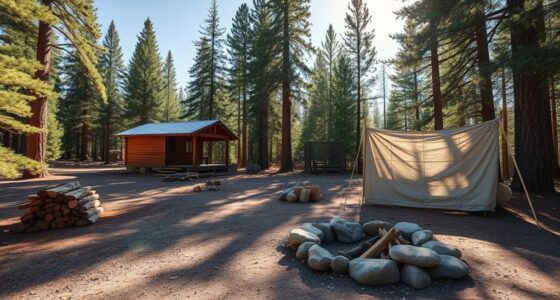When GPS fails, you can still find your way by observing natural cues. Use the sun’s position to determine east in the morning and west in the evening, and shadows to find east-west lines. At night, locate Polaris if you’re in the Northern Hemisphere, or identify the Southern Cross in the south. Recognizable landmarks help confirm your route. Keep practicing these skills, and you’ll improve your ability to navigate confidently without electronic devices. Learn more about mastering natural navigation techniques.
Key Takeaways
- Use the sun’s position at sunrise and sunset to determine east and west for basic orientation.
- Cast shadows with a stick to find east-west lines and identify cardinal directions when cloudy.
- Find Polaris in the night sky to locate true north in the northern hemisphere.
- Recognize landmarks like mountains, rivers, or buildings to confirm your location and maintain course.
- Combine celestial cues with land features for accurate navigation without GPS.

In a world dominated by digital navigation tools, learning to navigate without GPS can seem intimidating, but it’s a valuable skill that enhances your sense of direction and situational awareness. Relying solely on technology can make you complacent, and when those signals fade or devices fail, knowing how to read the sky and recognize landmarks keeps you grounded. The key is understanding the natural cues around you, which have guided explorers for centuries before GPS was even conceived. By paying attention to the sun, stars, and horizon, you can find your way with confidence. Recognizing traditional navigation techniques helps you develop a deeper understanding of your environment and improves your overall orientation skills.
Start with the sun. During the day, it rises in the east and sets in the west, creating a reliable directional guide. If you’re unsure which way is east, observe where the sun is positioned; it’s generally in the eastern sky in the morning and moves across to the west in the evening. Keep in mind that in the Northern Hemisphere, the sun appears slightly south at its highest point, so you can use that to gauge south and north. In the Southern Hemisphere, the sun is slightly north at its peak, so adjust your assumptions accordingly. Overcast days make this trickier, but shadows can still provide clues. A stick placed vertically in the ground will cast a shadow, and by marking the tip of the shadow at regular intervals, you can determine east-west lines.
Use the sun’s position and shadows to find east and west when the sky is cloudy.
At night, the stars become your guide. The North Star, Polaris, is a vital reference point if you’re in the northern hemisphere. Find the Big Dipper and follow the line from its two outer stars to Polaris, which indicates true north. Once you identify north, orient yourself by the other cardinal directions. In the southern hemisphere, the Southern Cross constellation points toward south, allowing you to determine your southern direction by locating the cross and extending an imaginary line through it.
Landmarks also serve as invaluable navigation aids. Recognize distinctive features like mountain peaks, rivers, or unique buildings and remember their positions relative to your route. Use them to confirm your location and direction periodically. If you’re hiking or traveling through unfamiliar terrain, map out your route beforehand, noting significant landmarks along the way. As you progress, frequently check your surroundings against your mental map to stay on course.
Combining celestial cues with landmark recognition creates a well-rounded navigation system that doesn’t depend on technology. Practice these skills regularly to build confidence and improve your ability to navigate confidently when electronics fail. Remember, nature offers constant clues, and with a keen eye and a little knowledge, you can find your way anywhere without GPS.
Frequently Asked Questions
How Can I Navigate at Night Without GPS?
You can navigate at night by using the stars and natural landmarks. Identify the North Star to find north, and use constellations like Orion to orient yourself. Look for prominent features such as hills, rivers, or trees to maintain your bearings. Trust your sense of direction, and keep track of your surroundings. Always carry a compass or a map as a backup, and move slowly to avoid losing your way.
What Are Traditional Methods for Finding North?
Imagine the compass rose guiding your journey. To find north traditionally, you can use the North Star, Polaris, which sits directly above Earth’s North Pole. At night, locate the Big Dipper and follow the “pointer” stars to Polaris. During the day, rely on the sun’s position—rising in the east and setting in the west—to estimate north. These ancient methods keep you oriented when modern tools fade away.
How Accurate Are Celestial Navigation Techniques?
Celestial navigation can be quite accurate if you have clear skies and good knowledge of the techniques. When you use a sextant to measure angles between celestial bodies and the horizon, you can determine your position within a few nautical miles. However, factors like weather, instrument quality, and your skill level influence accuracy. With practice, you can reliably navigate across open waters, even without GPS.
Can Landmarks Be Reliable in Unfamiliar Terrain?
Landmarks can be surprisingly reliable, but only if you choose wisely. In unfamiliar terrain, they may deceive you or be hard to identify, so stay alert. Look for distinctive features—mountains, rivers, unique trees—that stand out. Confirm your sightings with other clues like the sun or stars. Trust your instincts, but always double-check. When used carefully, landmarks become your guide, even in the most unknown landscapes.
What Tools Do I Need for Land-Based Navigation?
You’ll need a detailed map of the area and a compass to navigate land-based terrain effectively. A topographic map helps you understand elevation and terrain features, while a compass guides your direction. Additionally, carrying a protractor or a GPS app as backup can be helpful. Always plan your route beforehand, and keep these tools accessible to stay on course, especially when landmarks are limited or unfamiliar.
Conclusion
Remember, even without GPS, you’re the captain of your own journey. The sky and landmarks are like trusted old friends, guiding you through unknown waters when screens fail. Embrace these natural signposts, and you’ll discover that navigation isn’t just about reaching a destination — it’s about reconnecting with the world around you. Like stars in the night, your sense of direction can shine brightest when you trust your instincts and observe your surroundings.










